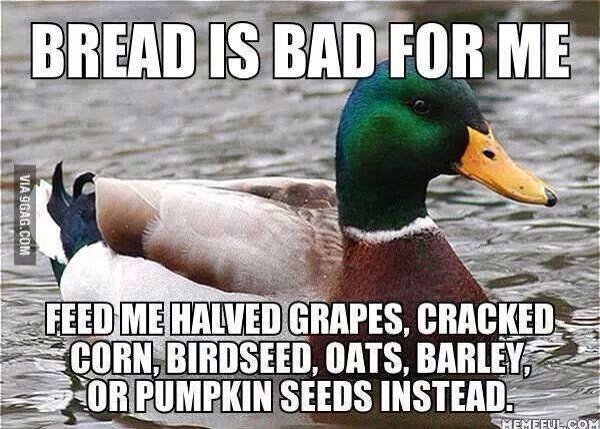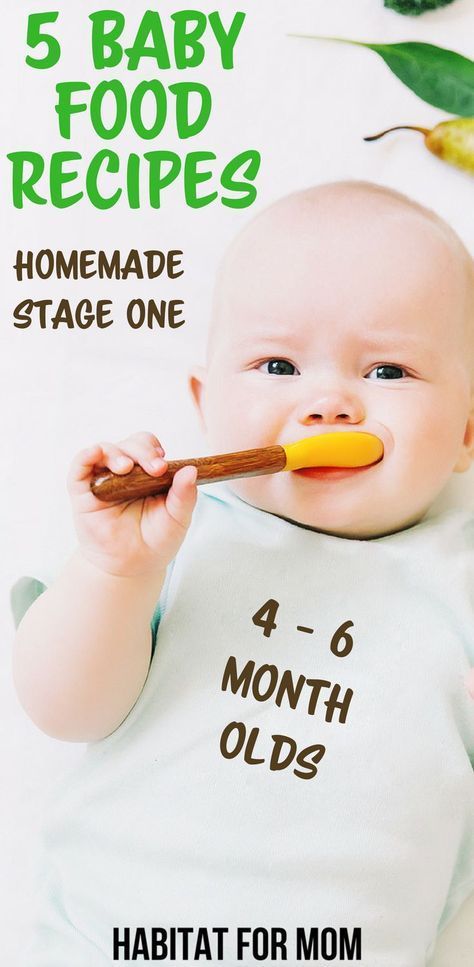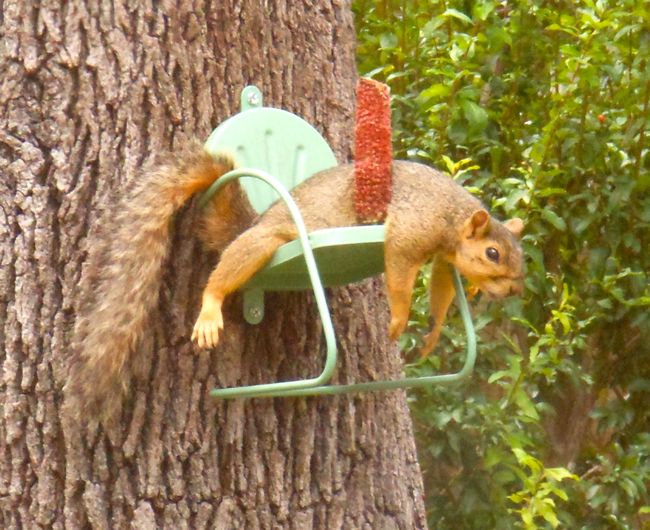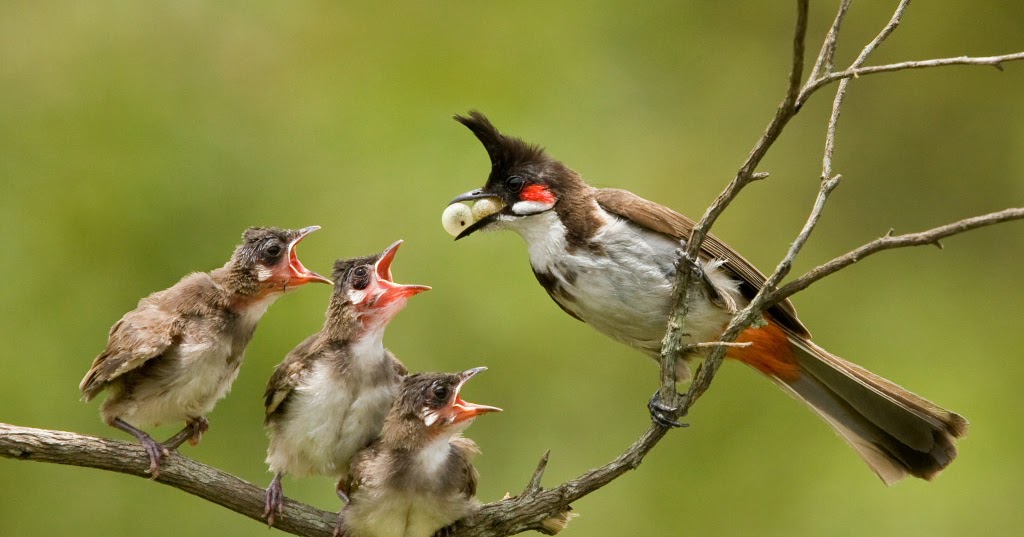Can i feed a baby bird bread
Can Baby Birds Eat Bread? (Safe or Bad?)
by Ethan Harris
Bread is one of the most consumed foods by humans and also one of the most controversial foods for birds. Many birdwatchers and people who love to feed birds have asked a question, can baby birds eat bread?
Honestly, I say that baby birds can eat bread, but the answer is not simple. You can feed bread to baby birds, but there is no sense in feeding them bread. Because bread does not provide any health benefits to baby birds, read to know the other reasons to avoid feeding bread.
Table of Contents:
- Is Bread Good For Baby Birds?
- Why Is Bread Not Suitable For Baby Birds?
- Can Bread Kill Baby Birds?
- Alternatives Of Bread For Feeding Baby Birds
- Final Thought
Pieces of bread are not bad for baby birds but are not too good because they contain relatively low nutrition. So, due to this reason, do not offer bread to your baby birds in large amounts.
If your baby bird’s diet includes bread only, then it will not develop into healthy a bird. From the bread, baby birds can get the protein they need to develop their feathers and muscles. But the fact they need to get energy is not available.
Why Is Bread Not Suitable For Baby Birds?Bread is not suitable for your baby birds because its dry chunks can choke the baby bird. Another problem makes bread a non-suitable food product for your baby birds, along with the choking issue.
The other problem is that bread has preservatives and harmful chemicals. Also, it is heavily processed, and all such things are not suitable for a baby bird’s health.
One more problem is that fresh or stale, both types of bread have almost zero nutrition for your baby birds, and if the bread is moldy, it can harm your baby bird.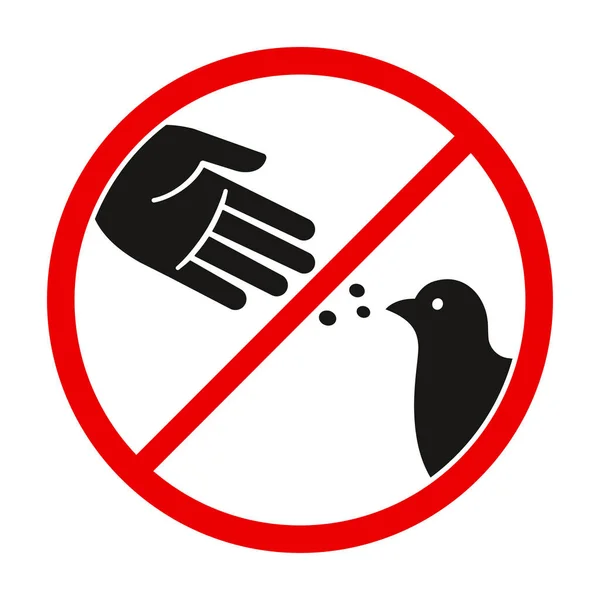 Bread can also make your baby bird fat.
Bread can also make your baby bird fat.
Not all types of bread can kill baby birds. Moldy bread is a very poisonous bread type and can even kill your baby birds. If your baby birds are lucky enough to survive, then some diseases can be caused, including the inability to fly, the malformation of feathers, and many more.
The other bread type which can kill your baby bird is dry bread. Again, choking can occur due to the intake of dry bread. Bread also does not have the nutrition necessary for your birds. That is why it is better not to serve bread to your baby bird.
Alternatives Of Bread For Feeding Baby BirdsBaby birds are tiny in size, and if their parent is not there to feed them, then the responsibility comes to you. While feeding anything, make sure it has good nutritional value because they need essential nutrients to grow well.
There are many bread alternatives for feeding your baby birds.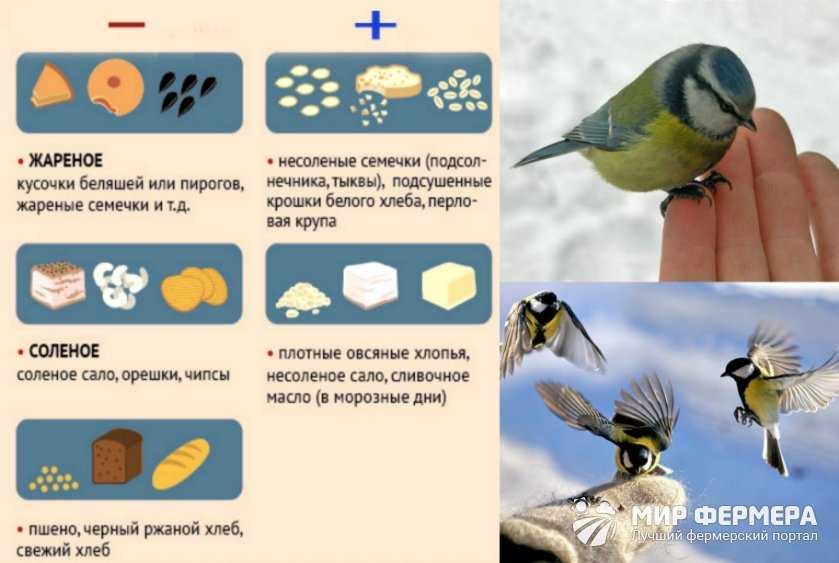 But the first thing that you have to do is to know the type of bird you have in your house or the garden.
But the first thing that you have to do is to know the type of bird you have in your house or the garden.
Some baby birds love to eat insects, while some birds love eating seeds, but they can eat everything at the start. However, baby birds eat whatever their birds eat.
You can feed the baby bird an egg yolk mixed in water (a small quantity). Please do not give the white part to them as it is not good for their health. Egg yolk is full of protein, and for your baby birds, it is a perfect food and helps your baby bird survive.
You can serve tiny seeds, cooked peas, or cooked corn to the baby birds who are seed lovers and insects to the insect lover. Also, serve boiled ground beef to your baby birds.
You can serve all these things with or without egg yolk. Never serve large and solid pieces to your baby birds. Hard-boiled eggs and raw liver without seasoning can be served to your baby birds.
Always serve these things in grind form.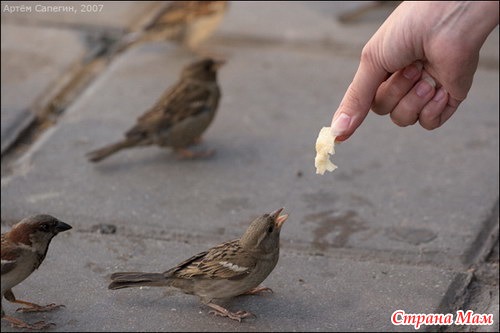 Some bird seeds, frozen peas or corn, oats, and any other green can be served to your baby birds as an alternative to bread.
Some bird seeds, frozen peas or corn, oats, and any other green can be served to your baby birds as an alternative to bread.
Along with these things, you can also serve them mealworms, waxworms, crickets, earthworms, nightcrawlers, grasshoppers, etc.
You should serve mealworms, waxworms, earthworms (you can grow them in your garden), and hard-boiled eggs in various small pieces so then baby birds will swallow them easily.
Final Thought
Feeding bread to baby birds is one of the debatable topics on the internet. Baby birds can eat bread but baby birds required foods that provide good nutritional value for their growth.
Bread does not have a good nutritional value for baby birds. That’s why it is not recommended to provide baby bird bread.
Ethan Harris
Hello! I am Ethan Harris, and I love to share about caring for birds, feeding birds, and many more things that you are searching for on the internet. Please do comment if you have any doubts.
Birdskeeping is supported by its readers. When you purchase through links on our site, we may earn an affiliate commission. Also, as an Amazon affiliate, we earn from qualifying purchases without costing you extra.
What Scraps Can I Feed To Birds? | Feeding Birds
Feeding garden birds doesn't need to be expensive - many of the things you throw away provide suitable food for birds!
Bacon and other fats
You can put out fat from unsalted cuts of meat in large pieces for the birds. Birds, such as tits, can remove morsels from them. Make sure they are well anchored to prevent large birds flying away with the whole piece! This kind of food can attract magpies and gulls, and also neighbourhood cats. If this is likely to be a problem, it's best avoided.
There is a lot of debate about the suitability of bacon rind, since much of it is salted during the curing process. As long as you can be sure the bacon is not salty, you can put it on your bird table. Since bacon can be too tough for many birds to tackle, chopping it finely will allow a wider variety of birds to eat it.
As long as you can be sure the bacon is not salty, you can put it on your bird table. Since bacon can be too tough for many birds to tackle, chopping it finely will allow a wider variety of birds to eat it.
Bread
All types of bread can be digested by birds, but ideally it should only be just one component in a varied diet. Bread does not contain the necessary protein and fat birds need from their diet, and so it can act as an empty filler. Although bread isn't harmful to birds, try not to offer it in large quantities, since its nutritional value is relatively low. A bird that is on a diet of predominantly, or only bread, can suffer from serious vitamin deficiencies, or starve.
Food left on the ground overnight can attract rats. Soaked bread is more easily ingested than stale dry bread, and brown bread is better than white. Crumbled bread is suitable in small quantities, but moisten if it is very dry.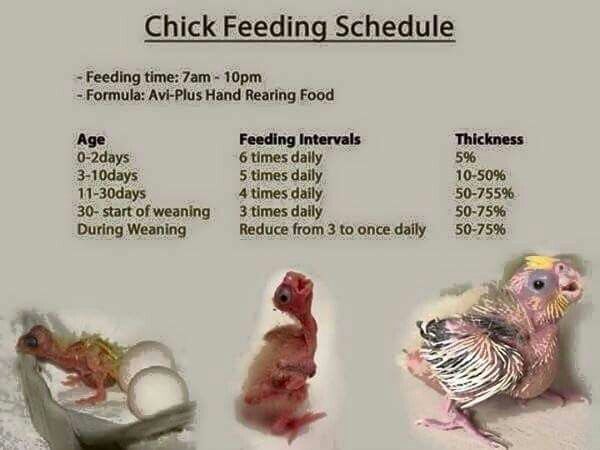 During the breeding season, make sure bread is crumbled into tiny pieces so that it is safer to eat. Dry chunks of bread will choke baby birds, and a chick on a diet of bread may not develop into a healthy fledgling.
During the breeding season, make sure bread is crumbled into tiny pieces so that it is safer to eat. Dry chunks of bread will choke baby birds, and a chick on a diet of bread may not develop into a healthy fledgling.
Other
Fat
Fat, including suet, is particularly welcomed by tits, great spotted woodpeckers, thrushes and wrens. However, please avoid polyunsaturated fats - they don't give the birds the high levels of energy they require in winter.
Cheese
Mild grated cheese is a favourite with robins, dunnocks, blackbirds and song thrushes. It will also help wrens if you place it under hedgerows and other areas in your garden where you've noticed them feeding.
Potatoes
Baked potatoes (cold and opened up), roast and even mashed potatoes with added real fats are all suitable food for birds. Chips are rarely eaten by birds.
Fruit
Dried fruits, such as raisins, sultanas and currants are particularly enjoyed by blackbirds, song thrushes and robins. Soak them during spring and summer.
Soak them during spring and summer.
NOTE: as some dogs and cats react badly to these fruits please do not put them out in areas where these animals might get to them.
Apples, pears and other fruit, including bruised and part rotten ones, cut up, are very popular with all thrushes, tits and starlings.
Pastry
Pastry, cooked or uncooked, is excellent - especially if it has been made with real fats.
Salt
Garden birds are practically unable to metabolise salt. It is toxic to them in high quantities and affects their nervous system. Under normal circumstances in the wild, birds are unlikely to take harmful amounts of salt. Never put out salted food onto the bird table, and never add salt to bird baths to keep water ice-free in the winter.
Hygiene
Remember to keep your garden birds fit, healthy and disease free by keeping feeders, bird tables and bird baths squeaky clean.
How to save a chick that has fallen out of the nest | Encyclopedia of Animals
With the advent of warm weather, our forests and gardens are filled with bird songs, and people, in turn, try to spend as much time as possible outdoors.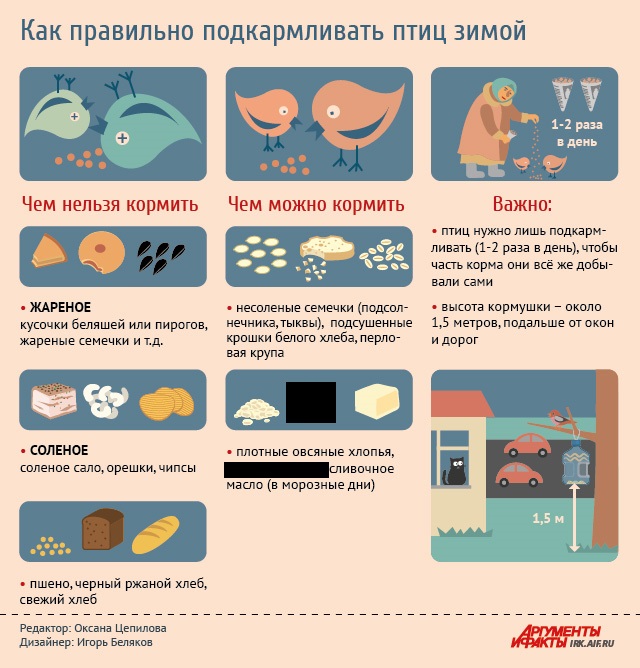 During outdoor recreation, helpless chicks are often found. Naturally, there is a desire to save the life of a baby, but not everyone knows how to save a chick that has fallen out of the nest. Let's see how we can help him.
During outdoor recreation, helpless chicks are often found. Naturally, there is a desire to save the life of a baby, but not everyone knows how to save a chick that has fallen out of the nest. Let's see how we can help him.
To save or not to save - that is the question
The first thought that arises when looking at a fledgling and flightless chick is “fell out of the nest”, “lost” and even “parents abandoned and forgot”. In fact, the chick is alone, no brothers, sisters, or adult birds are visible nearby, and it also screams loudly. How can you help here? But the fact of the matter is that help in 95% of cases in such situations is not needed.
The fact is that in many birds (primarily small passerines) chicks leave the nest as half-fledged fledglings. During this period of life, they still do not know how to fly, but they are already actively exploring the surrounding space - they climb branches, clumsily flit. It is these rather active chicks that fall into the field of human vision.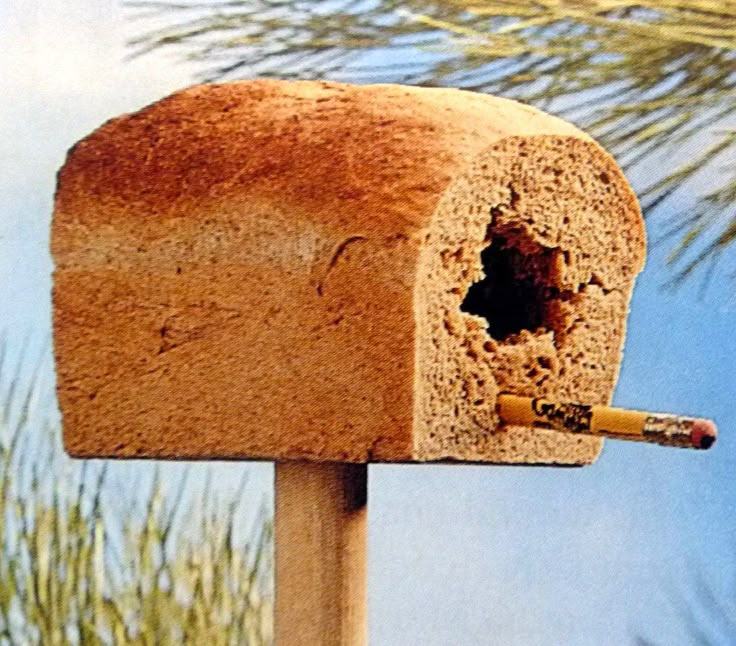 It is easy to determine the fledgling in appearance: it is feathered or covered with rudiments of unopened feathers; the chick is quite large (about 50-70% of the size of a sparrow), it is often active, that is, it opens its mouth and asks for food. Parents did not abandon this chick, but simply flew away for food. Of course, while you are standing next to the chick, they will not make themselves felt. And if you stay too long, then there is a chance that the parents will leave him out of concern. nine0003
It is easy to determine the fledgling in appearance: it is feathered or covered with rudiments of unopened feathers; the chick is quite large (about 50-70% of the size of a sparrow), it is often active, that is, it opens its mouth and asks for food. Parents did not abandon this chick, but simply flew away for food. Of course, while you are standing next to the chick, they will not make themselves felt. And if you stay too long, then there is a chance that the parents will leave him out of concern. nine0003
Even if the chick looks too small and helpless, don't rush to classify it as an orphan. Birds such as warblers, warblers, larks, wagtails nest on the ground, their chicks spend their entire childhood on the grass. Your presence in this situation is also undesirable because magpies and crows track human behavior. Smart birds can check after you leave what you saw there, find and kill the chick. Hence the conclusion: do not "save" everything that catches your eye. If the chick is dry, warm, active, well feathered, then he does not need help.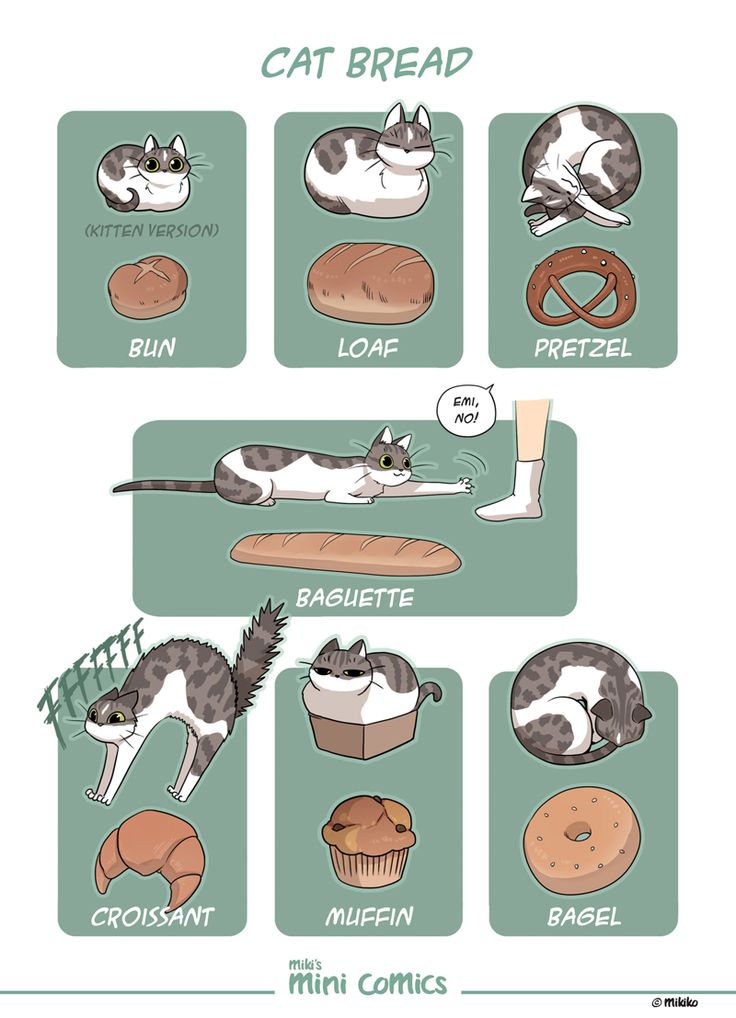 nine0003
nine0003
What if the situation causes concern? Perhaps the chick is too weak or obviously fell out of the nest from a great height and cannot be returned to its parents. In this case, you can try to save him, but keep in mind that the likelihood of success will be directly proportional to your diligence, and you will have to put in a lot of work.
What to do first
- Quickly and carefully inspect the place where you found the chick, remember how it looks. In some cases, this will help determine the type of bird. nine0022
- Pick up the chick (don't squeeze too hard!) and bring him home as soon as possible.
- On the way, inspect the chick for damage. If the bird has clearly visible fractures of the paws, wings, concussion (how to define it a little lower), then you can’t do without a veterinarian. It is highly desirable to seek help from a veterinarian who specializes specifically in the treatment of birds (unfortunately, such specialists are extremely rare).
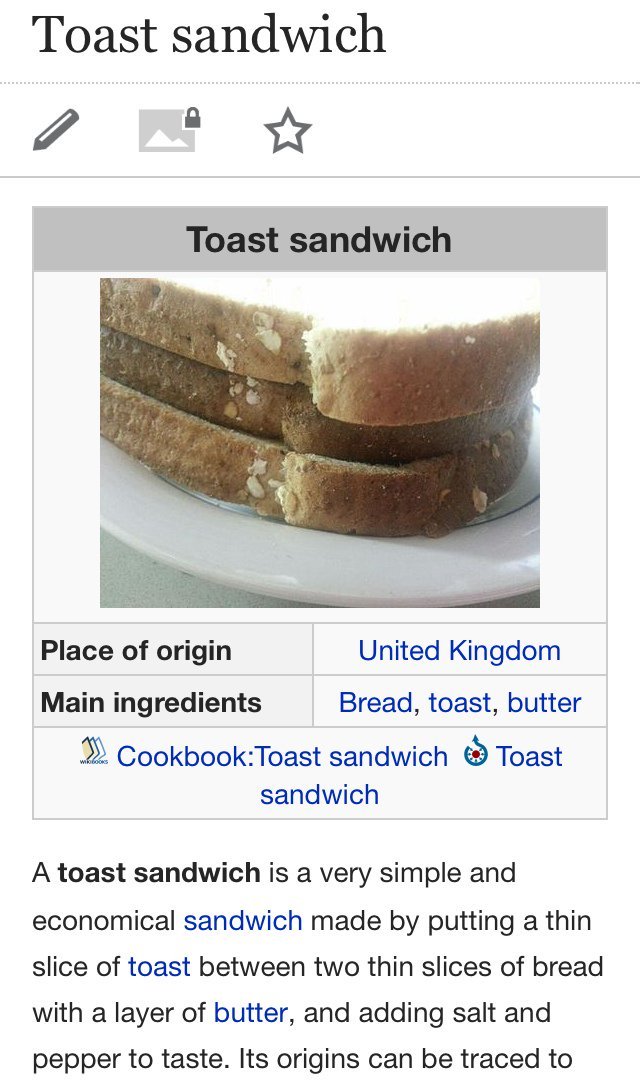 If there are no obvious signs of a fracture, and the general condition of the chick is satisfactory, then it is better not to torment him, but simply to provide good conditions - nature will do its job and he will recover. nine0022
If there are no obvious signs of a fracture, and the general condition of the chick is satisfactory, then it is better not to torment him, but simply to provide good conditions - nature will do its job and he will recover. nine0022 - Providing a chick with food as soon as possible is even more important than furnishing a home for it.
Now a few words on how to define contusion. Usually, chicks get severe bruises either from hitting the ground or when they collide with cars. At the same time, the bird has no wounds on the outside, but a concussion is observed. True signs of this condition are bleeding from the nostrils, paralysis of both legs or paralysis of half of the body (paw and wing on one side), closure of one eye, or unequal degree of pupil dilation on the injured and healthy side of the body. nine0003
What to feed
You may think that feeding a chick is easy - crumble bread and crumble. But here you will find disappointment number 2. Chicks do not eat bread, crackers, porridge, cereals, seeds. They don't eat at all. Even the chicks of granivorous birds do not take dry food at first. And the reason is that the growing organism needs proteins, therefore, in nature, even granivorous birds feed their offspring with animal food and exceptionally soft food. You will have to do the same. Pigeons are the only exception. They feed the chicks with goiter secretions - bird's milk, and then with semi-digested grains. If you picked up a pigeon chick, then you can feed it with unsalted porridge, gradually reducing the degree of cooking. In other cases, the best food for the chick is mealworms, cockroaches, crickets, darkling larvae - zoophobus (all these foods are sold in pet stores), earthworms (you can dig up), caterpillars (you will have to collect), a boiled egg (only as an additional food, and not a substitute for anything and everything). Even if you have provided the chick with the listed food, it is recommended to periodically catch bugs, grasshoppers, butterflies, flies, mosquitoes and give these insects to him, because the more varied the diet, the healthier your ward will grow.
 Very weak chicks should be given glucose-sweetened water (not sugar syrup!), instead of solid food, for the first few hours. nine0003
Very weak chicks should be given glucose-sweetened water (not sugar syrup!), instead of solid food, for the first few hours. nine0003
What not to feed the chicks
- dead insects - no matter what species they belong to and wherever you find them. In nature, insects almost never live to old age, rather someone will eat them. If you find a dead cockroach behind the stove or a dead locust in the garden, do not rush to rejoice. Most likely, this individual died from an insecticide, which means that the poison from the feed can enter the body of the chick and greatly harm its already poor health; nine0022
- Colorado potato beetles - adults, larvae and eggs are poisonous in this species. They are not eaten by any species of birds, so this easily accessible resource will have to be forgotten;
- ladybugs - they secrete a moderately toxic liquid, in nature a bird that catches such a bug by mistake will spit it out.
 In captivity, especially in the case of force-feeding the chick, he does not have the opportunity to refuse harmful food, so he can get poisoned;
In captivity, especially in the case of force-feeding the chick, he does not have the opportunity to refuse harmful food, so he can get poisoned; - hairy caterpillars - firstly, they can be poisonous, and secondly, the villi during feeding can clog the chick's goiter and it will die. Although cuckoos and orioles can eat in the temperate hairy strip, it is still better to play it safe and not use this food;
- brightly colored bugs - in nature, many birds willingly peck at such insects, but this mainly concerns nondescript turtle bugs. The back of the bug, decorated with bright spots or stripes, is of a warning nature - "do not eat me, it will be worse for you." For safety net, it is not necessary to catch such specimens for the chick. nine0022
How to feed
The main thing you need to know from the very beginning is that birds have a very high metabolism, and small chicks have a huge metabolic rate.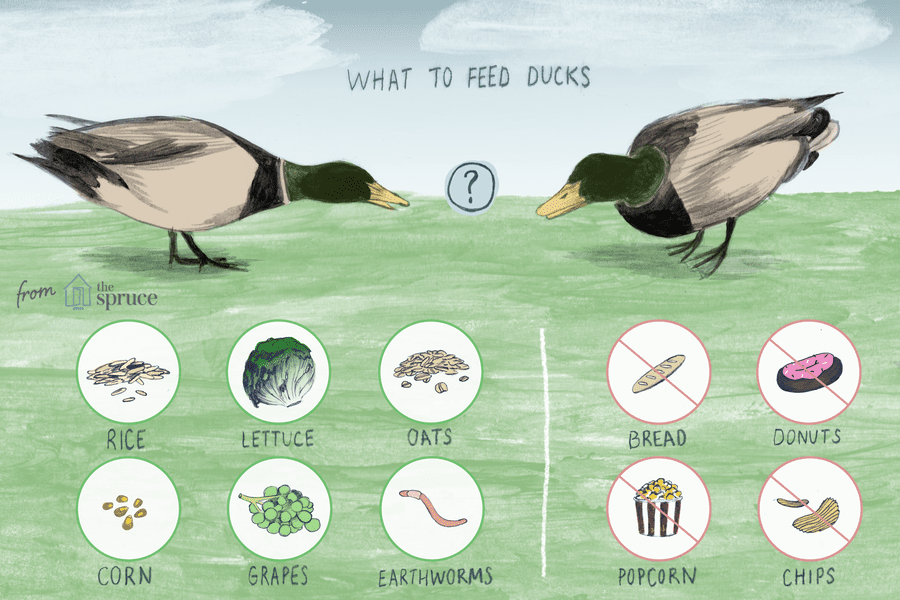 Any food eaten by the chicks is digested very quickly and they need to be fed again and again. In nature, parents jointly feed the brood 100-500 times a day! This means that every 10-15 minutes the chick needs to be fed. And don't expect to overtrain him! A chick deprived of food instantly weakens, a couple of hours of hunger is enough for it to die. You will have to provide the baby with constant supervision, feed him at first every 15 minutes, and when he grows up a little, after 20-30. But you need to take a break at night, but start the first feeding no later than 6 o'clock in the morning! Evening feeding is completed around sunset, that is, around 22.00. nine0003
Any food eaten by the chicks is digested very quickly and they need to be fed again and again. In nature, parents jointly feed the brood 100-500 times a day! This means that every 10-15 minutes the chick needs to be fed. And don't expect to overtrain him! A chick deprived of food instantly weakens, a couple of hours of hunger is enough for it to die. You will have to provide the baby with constant supervision, feed him at first every 15 minutes, and when he grows up a little, after 20-30. But you need to take a break at night, but start the first feeding no later than 6 o'clock in the morning! Evening feeding is completed around sunset, that is, around 22.00. nine0003
It is more convenient to bring food with tweezers. In general, tactile contact should be kept to a minimum, frequent touching is stressful for the tiny creature, and it worsens the condition of down and feathers. If the chick is very small and naked, then it is not necessary to give it a whole large insects. In this case, it is better to cut them with tweezers and feed them in pieces. It is also recommended to remove hard elytra from large beetles, long legs from grasshoppers and locusts. Often the chicks refuse to take any food. This happens because they do not recognize you as their mother, or they are so weak that they have lost their appetite. In this case, you will have to force-feed the ward. To do this, you need to crush the food and fill it with a syringe without a needle (you can add a couple of drops of water to dilute the mixture). Take the bird in your left hand and gently spread its beak with your fingers, insert a syringe into its mouth with your right hand and squeeze out about 1 cm³ of slurry. Do not overdo it! In tiny chicks, the beak is easily broken, and this is already a fatal injury. For greater convenience, a flexible tube can be put on the end of the syringe. nine0003
It is also recommended to remove hard elytra from large beetles, long legs from grasshoppers and locusts. Often the chicks refuse to take any food. This happens because they do not recognize you as their mother, or they are so weak that they have lost their appetite. In this case, you will have to force-feed the ward. To do this, you need to crush the food and fill it with a syringe without a needle (you can add a couple of drops of water to dilute the mixture). Take the bird in your left hand and gently spread its beak with your fingers, insert a syringe into its mouth with your right hand and squeeze out about 1 cm³ of slurry. Do not overdo it! In tiny chicks, the beak is easily broken, and this is already a fatal injury. For greater convenience, a flexible tube can be put on the end of the syringe. nine0003
Where to house
If the first difficulties do not dampen your enthusiasm, then you should provide the chick with shelter in your home. First of all, you need to make a nest.
Take a deep bowl or cardboard box with a rim about 10 cm high. Fill this container with sawdust, dry clean sand, hay, straw, scraps of cloth, make a recess in the middle that imitates the nest tray. Do not fill the container with fresh grass, raw material can cause hypothermia of the chick, because there is no one to warm it in an artificial house. By the way, if you are seriously engaged in rescue, you can purchase a small thermal mat at the pet store, it will to some extent replace the mother's warmth for your pupil. Also, cotton wool, yarn, fabrics with a rare weave of threads can be considered dangerous fillers. The paws of a chick are easily tangled in such material, and a tightened thread can even amputate the fingers of a feathered baby. Lay a paper napkin in the tray in 2-3 layers. Chicks defecate as often as they eat; in nature, their parents monitor their hygiene and take the litter out of the nest. You just need to change the napkin after each feeding. So, the nest is ready. nine0003
nine0003
Now we need to think about security. In the house of the savior, stupid children, blind-sighted grandmothers, dogs, cats can live, and there are also curious neighbors who have dropped in for a minute. All these creatures threaten the life of a little chick: children can grab it and squeeze it in a fist (certain death), dogs and cats can arrange a hunt (you won’t even find feathers), a blind grandmother will sit by chance on a box (well, don’t execute the old woman for this), and noisy neighbors can accidentally knock it over (“Tanya, I’ll come to you for a second for salt, oh, it seems that something has fallen here!”). To prevent trouble, it is better to place the nest in a cage or an aquarium covered with gauze. In the cage, do not try to put the chick on the perch, do not place it in closed containers (jars, etc.). Don't nest on high ground. The fact is that a weak chick can get stronger and, unexpectedly for you, will go to explore the surrounding space. He is guaranteed to fall out of his shelter and, unlike the forest and the meadow, it will not be soft grass waiting for him at the bottom, but the floor. You should not put the box with the chick in the sun, so you will not warm it, and the helpless bird is guaranteed to get sunstroke and may die. Drafts are very dangerous. nine0003
You should not put the box with the chick in the sun, so you will not warm it, and the helpless bird is guaranteed to get sunstroke and may die. Drafts are very dangerous. nine0003
Do chicks need water?
In nature, chicks of passerines do not need water, as they get enough moisture with food. After all, adult birds do not bring them water in their beaks. At home, you can do without watering the chick if you follow the diet, that is, you give a variety of, and most importantly, “wet” food - earthworms, fatty juicy caterpillars. Flies, cockroaches, crickets (they are most often bought in a store) can be conditionally classified as “dry” food. They do not give the chick enough moisture. In this case, he can instill a few drops of liquid from a pipette, but do this not at every feeding, but a little less often. Please note that shell-shocked chicks should not be given water. nine0003
What to do next?
Fortunately, the chicks grow up quickly and the period of trouble soon passes, in a week or two your ward may get stronger. In order for the feeding process to be completed successfully, do not forget to gradually accustom the chick to adult food. For granivorous birds, this can be porridge cooked without salt, small grains (millet, rice chaff). Chicks of insectivorous species will have to be supplemented with insects. No matter how hard you try, your chick will be weaker than its wild counterparts and completely unsuitable for independent living. There is nothing you can do to help him, so you have to take responsibility for his life. The grown bird will have to be left as a room. If you are not ready to keep a bird (you need to think about this from the very beginning), then it is better not to take the chick home at all. So he will have at least a meager chance to survive. But if you are not afraid of difficulties, then the saved life of the feathered one will be the reward for the labors. nine0003
In order for the feeding process to be completed successfully, do not forget to gradually accustom the chick to adult food. For granivorous birds, this can be porridge cooked without salt, small grains (millet, rice chaff). Chicks of insectivorous species will have to be supplemented with insects. No matter how hard you try, your chick will be weaker than its wild counterparts and completely unsuitable for independent living. There is nothing you can do to help him, so you have to take responsibility for his life. The grown bird will have to be left as a room. If you are not ready to keep a bird (you need to think about this from the very beginning), then it is better not to take the chick home at all. So he will have at least a meager chance to survive. But if you are not afraid of difficulties, then the saved life of the feathered one will be the reward for the labors. nine0003
The recommendations in this article are mainly focused on the rearing of passerines and pigeons, as these are the most commonly found.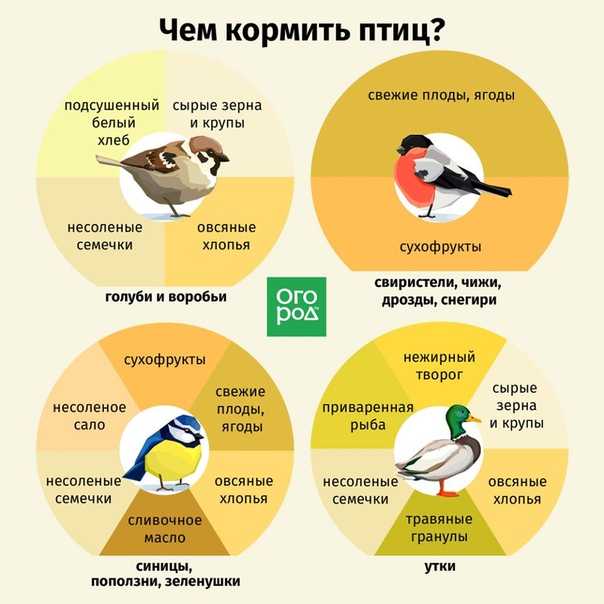 Chicks of large birds (eagles, cranes, owls, storks, etc.) are best transferred to the zoo, where they are guaranteed professional veterinary care.
Chicks of large birds (eagles, cranes, owls, storks, etc.) are best transferred to the zoo, where they are guaranteed professional veterinary care.
How do you like the article?
What to feed sparrows - a feeder and home conditions
You are here: Home / Birds / Bird care
Maya Barsukova •
Sparrows are the most familiar and favorite birds of adults and children. But few people thought about how to feed the sparrows, because there has always been the idea that they are omnivores. Some foods can harm the health of these little feathered friends of man.
What to feed a sparrow in a feeder
The most common feeding option for birds is bread. However, a long loaf and other flour products can hardly be called a useful food product for sparrows, rather the opposite. Zoologists recommend feeding birds with cereals (rice, millet, buckwheat, oatmeal, barley), as well as many types of seeds. The most popular are sunflower seeds. Seeds should be given raw. As a protein supplement, sparrows can be offered pieces of lard, cut very finely. nine0003
It is not recommended to feed the birds with wet seeds or soaked bread, because in the cold they quickly turn into ice, and the bird will not bite through such food.
How to feed a sparrow at home
If it was decided to leave the sparrow at home, then caring for the bird will require some effort and time, you need to be patient. Sparrow eating schedule is frequent, every 1-2 hours. If the sparrow does not receive its food norm on time, it will feel bad and even fatal. nine0003
The diet must be complete. Since birds mostly eat grain, for a feathered one you need to buy a mixture of cereals at the pet store. Due to the fact that the sparrow is not a poultry, there is no target food for this species of bird on sale. But if you consult the seller, an experienced specialist will always offer a suitable option for the finished grain mixture.
In addition to cereals, the bird can be given a chopped boiled egg, pieces of raw meat. Insects are also an important part of the diet. In the warm season, you can catch grasshoppers and caterpillars for birds. And in the cold, you will have to go to the pet store and purchase live insects. nine0003
In addition to this, you need to feed the sparrow at home with vegetables and fruits, but they should be given only in grated form, since the sparrow's beak is not able to capture large pieces. Gray birds love apples, carrots, beets, bananas, pumpkins, and corn.
What not to feed sparrows
- Black and dried bread. Black bread is contraindicated for sparrows, and stale, hardened bread can disrupt digestion or lead to other diseases of the digestive tract. nine0022
- Dried insects (flies, cockroaches, crickets). If dead and old insects are found at home, then you can’t feed them to a feathered one, it can get poisoned or die.
- Flies and midges stuck to sticky tape.

- Stuffing from semi-finished products (dumplings, pasties, dumplings, pancakes with meat).
- Cow or powdered milk. Sparrows are lactose intolerant.
- Stale mixtures or feed. The bird's stomach is sensitive, so you should check the expiration dates of the goods in stores. nine0022
- Earthworms. There is an opinion that worms are useful for birds, but they often carry infectious diseases and helminthic invasion, so you should not experiment.
- Tablets or vitamins without veterinary prescription.
What to feed sparrow chicks
If a sparrow chick is without feathers, then it is a few days old. To feed such tender chicks, a liquid feed mixture is needed.
The recipe is as follows:
- 1 chicken egg - can be replaced with a quail; nine0022
- boiled wheat, approx. 20 gr;
- raw grated carrots, 15 gr. without juice;
- finely chopped lettuce, 10 gr;
- boiled beef, 15 gr;
- 1 calcium tablet.
